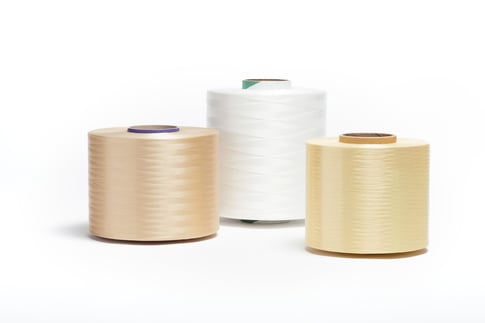 When a manufacturer is seeking a synthetic fiber that addresses heat and flame resistance, or one that demands extreme tensile strength, two materials immediately come to mind, the commercially branded Dupont™ Nomex® and Kevlar® composite materials. Each of these belong to the class of aramid fibers with the general characteristics which include a high melting point, a high strength to weight ratio and low elongation at break. These composite materials were developed by Dupont™ labs in the sixties and although Nomex® and Kevlar® are similar, they belong in different 'aromatic polyamide' classes, that is the meta-aramid and para-aramid fibers, respectively.
When a manufacturer is seeking a synthetic fiber that addresses heat and flame resistance, or one that demands extreme tensile strength, two materials immediately come to mind, the commercially branded Dupont™ Nomex® and Kevlar® composite materials. Each of these belong to the class of aramid fibers with the general characteristics which include a high melting point, a high strength to weight ratio and low elongation at break. These composite materials were developed by Dupont™ labs in the sixties and although Nomex® and Kevlar® are similar, they belong in different 'aromatic polyamide' classes, that is the meta-aramid and para-aramid fibers, respectively.
So what are the differences between Meta-Aramid and Para-Aramid yarns?
Meta-Aramids (such as Nomex®) are highly resistant to temperature, chemical degradation, and abrasion. A meta-aramid fiber is usually manufactured by spinning in a chemical solution, know as wet spinning. The result is a semi-crystalline fiber with its molecular chain partially oriented along the axis of the fiber. M-aramid fibers generally have a Tenacity of about 5.6g/den, which can compare to Mid-Tenacity nylon and polyester fibers. These fibers are unique in their ability to withstand tensile stress during exposure to flames and temperatures up to 400 deg. C.
Para-aramids (such as Kevlar® and lower cost alternatives) display high tensile strength (the maximum stress that a material can withstand) and modulus behavior(the tendency of a material to deform when force is applied). These fibers are created by the the dry-jet, wet spinning method resulting in a fiber which consists of fully extended liquid crystal chains formed along the fiber axis with a high degree of crystallinity which increases the fiber's strength. The p-aramid fibers can be manufactured with Tenacity around 23g/den and elongation at break ~3.5%.
Applications for m-aramids include electrical insulation, protective clothing for firefighters and other first responders, auto racers and military personnel; along with automotive heat shields and aerospace applications. P-aramid applications include ballistics protection, race cars, protective gloves, wire and cable, and hose reinforcement. These two remarkable fibers have been instrumental in protecting the lives of people all over the world, while advancing materials science engineering techniques.
Do you need help determining the best aramid yarn or thread for your application? Contact us today.



